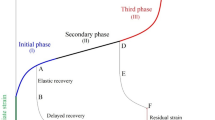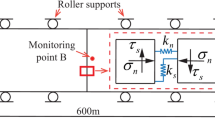Abstract
The time-dependent rheological deformation of rocks has significance in the stability of rock structures. The study of time-dependent rock behaviors is commonly conducted with creep or relaxation rheology tests in laboratories. In this study, generalized relaxation behavior, which indicates the strain and stress change simultaneously with time during rheology, is investigated to extend the aspects of the time dependency of rock. The definition and mechanism of generalized relaxation are explained with simple models. Then, triaxial generalized relaxation tests were performed under different stress levels. The results show that the evolution curves of strain and stress with time show similar tendencies with conventional creep or relaxation during generalized relaxation and can be described using a power function. As the stress level increases, the initial damage to the rock increases; moreover, variations in strain and stress and their rates increase, which are explained by crack propagation. Finally, the complete generalized relaxation curves are discussed and compared with the complete creep and relaxation curves. This study is significant for understanding the time-dependent behaviors of rock and stability analysis of underground rock structures.
Highlights
-
The definition and mechanism of generalized relaxation are explained with simple models.
-
The effect of stress level on generalized relaxation behavior of Tage tuff is studied under triaxial compression.
-
The evolution curves of generalized relaxation show similar tendencies to creep and relaxation.
-
The complete curves of generalized relaxation are obtained and three stages are divided.













Similar content being viewed by others
Data availability
Not applicable.
References
Aydan O et al (2014) ISRM suggested methods for determining the creep characteristics of rock. Rock Mech Rock Eng 47(1):275–290
Bieniawski ZT (1967) Mechanism of brittle fracture of rock: Part II experimental studies. Int J Mech Mini Sci Geomech Abst 4(4):407–423
Bieniawski ZT (1970) Time-dependent behaviour of fractured rock. Rock Mech Rock Eng 2(3):123–137
Borja R (1992) Generalized creep and stress relaxation model for clays. J Geotech Eng 118(11):770–772
Brace WF, Paulding BW, Scholz C (1966) Dilatancy in fracture of crystalline rocks. J Geophys Res 71(16):3939–3953
Brantut N, Heap MJ, Meredith PG, Baud P (2013) Time-dependent cracking and brittle creep in crustal rocks: A review. J Struct Geol 52(5):17–43
Byerlee J (1978) A review of rock mechanics studies in the United States pertinent to earthquake prediction. Pure Appl Geophy 116(4):586–602
Cai M et al (2004) Generalized crack initiation and crack damage stress thresholds of brittle rock masses near underground excavations. Int J Rock Mech Min Sci 41(5):833–847
Chen C, Xu J, Okubo S, Peng S (2020) Damage evolution of tuff under cyclic tension–compression loading based on 3D digital image correlation. Eng Geol 275:105736. https://doi.org/10.1016/j.enggeo.2020.105736
Chen C, Xu T, Zhou G, Qin T (2021) Experimental investigation of influence of alternating cyclic loadings on creep behaviors of sandstone. Mech Time-Depend Mater 25:1–19
Cong L, Hu X (2017) Triaxial rheological property of sandstone under low confining pressure. Eng Geol 231:45–55
Diederichs MS, Kaiser PK, Eberhardt E (2004) Damage initiation and propagation in hard rock during tunnelling and the influence of near-face stress rotation. Int J Rock Mech Min Sci 41(5):785–812
Eberhardt ED, Stead BS, Read RS (1998) Identifying crack initiation and propagation thresholds in brittle rock. Can Geotech J 35:222–233
Ezaoui A, Tatsuoka F, Duttine A, Di Benedetto H (2011) Creep failure of geomaterials and its numerical simulation. Geotech Letters 1:41–45
Fabre G, Pellet F (2006) Creep and time-dependent damage in argillaceous rocks. Int J Rock Mech Min Sci 43(6):950–960
Fairhurst CE, Hudson JA (1999) Draft ISRM suggested method for the complete stress-strain curve for the intact rock in uniaxial compression. Int J Rock Mech Min Sci & Geomech Abst 36(3):281–289
Fukui K, Okubo S, Nishimatsu Y (1992) Generalized relaxation behaviour of rock under uniaxial compression. Shigen-to-Sozai 108(7):543–548
Funatsu T, Seto M, Shimada H, Matsui K, Kuruppu M (2004) Combined effects of increasing temperature and confining pressure on the fracture toughness of clay bearing rocks. Int J Rock Mech Min Sci 41(6):927–938
Hashiba K, Fukui K (2015) Index of loading-rate dependency of rock strength. Rock Mech Rock Eng 48(2):859–865
Hashiba K, Fukui K (2016) Time-dependent behaviors of granite: loading-rate dependence, creep, and relaxation. Rock Mech Rock Eng 49(7):2569–2580
Hashiba K, Fukui K, Kataoka M (2019) Effects of water saturation on the strength and loading-rate dependence of andesite. Int J Rock Mech Min Sci 117:142–149
He C, Okubo S, Nishimatsu Y (1990) A study on the class-II behavior of rock. Rock Mech Rock Eng 23(4):261–273
Huang P, Zhang J, Spearing AJSS, Chai J, Dong C (2021) Experimental study of the creep properties of coal considering initial damage. Int J Rock Mech Min Sci 139:104629
Hudson JA (1971) Effect of time on the mechanical behaviour of failed rock. Nature (london) 232(5307):185–186
Kiersch G (1964) Vaiont reservoir disaster. Civ Eng 34(3):32–39
Kim J, Lee K, Cho W, Choi H, Cho G (2015) A comparative evaluation of stress-strain and acoustic emission methods for quantitative damage assessments of brittle rock. Rock Mech Rock Eng 48(2):495–508
Lajtai EZ (1974) Brittle fracture in compression. Int J Fract 10(4):525–536
Lee B, Rathnaweera TD (2016) Stress threshold identification of progressive fracturing in Bukit Timah granite under uniaxial and triaxial stress conditions. Geomech Geophys Geo-Energy Geo-Res 2(4):301–330
Martin CD, Chandler NA (1994) The progressive fracture of Lac du Bonnet granite. Int J Rock Mech Min Sci Geomech Abstr 36(6):643–659
Nicksiar M, Martin CD (2013) Crack initiation stress in low porosity crystalline and sedimentary rocks. Eng Geol 154:64–76
Okubo S, Nishimatsu Y (1985) Uniaxial compression testing using a linear combination of stress and strain as the control variable. Int J Rock Mech Min Sci Geomech Abst 22(5):323–330
Okubo S, Fukui K, Gao X (2008) Rheological behaviour and model for porous rocks under air-dried and water-saturated conditions. Open Civil Eng J 2:88–98
Paraskevopoulou C, Perras M, Diederichs M, Amann F, Löw S, Lam T, Jensen M (2017) The three stages of stress relaxation-Observations for the time-dependent behaviour of brittle rocks based on laboratory testing. Eng Geol 216:56–75
Peng S, Podnieks ER (1972) Relaxation and the behavior of failed rock. Int J Rock Mech Min Sci 9(6):699–712
Pepe G, Mineo S, Pappalardo G, Cevasco A (2018) Relation between crack initiation-damage stress thresholds and failure strength of intact rock. Bull Eng Geol Env 77(4):709–724
Sano O, Ito I, Terada M (1981) Influence of strain rate on dilatancy and strength of Oshima granite under uniaxial compression. J Geophys Res Solid Earth 86(10):9299–9311
Tang SB, Yu CY, Heap MJ, Chen PZ, Ren YG (2018) The influence of water saturation on the short- and long-term mechanical behavior of red sandstone. Rock Mech Rock Eng 51(9):2669–2687
Tang Y, Okubo S, Xu J, Peng S (2019) Progressive failure behaviors and crack evolution of rocks under triaxial compression by 3D digital image correlation. Eng Geol 249:172–185
Wang SY, Sloan SW, Huang ML, Tang CA (2011) Numerical study of failure mechanism of serial and parallel rock pillars. Rock Mech Rock Eng 44(2):179–198
Wang J, Zhang Q, Song Z, Zhang Y (2020) Creep properties and damage constitutive model of salt rock under uniaxial compression. Int J Damage Mech 29(6):902–922
Wang J, Zhang Q, Song Z, Zhang Y, Liu X (2021a) Mechanical properties and damage constitutive model for uniaxial compression of salt rock at different loading rates. Int J Damage Mech 30(5):739–763
Wang Y et al (2021b) Creep behaviour of saturated purple mudstone under triaxial compression. Eng Geol 288:106159
Wen T, Tang H, Ma J, Wang Y (2018) Evaluation of methods for determining crack initiation stress under compression. Eng Geol 235:81–97
Xue L et al (2014) A study on crack damage stress thresholds of different rock types based on uniaxial compression tests. Rock Mech Rock Eng 47(4):1183–1195
Yamaguchi U, Shimotani T (1986) A case study of slope failure in a limestone quarry. Int J Rock Mech Min Sci Geomech Abst 23(1):95–104
Yu C et al (2019) The effect of water on the creep behavior of red sandstone. Eng Geol 253:64–74
Zhang Y, Shao J, Xu W, Jia Y (2016) Time-dependent behavior of cataclastic rocks in a multi-loading triaxial creep test. Rock Mech Rock Eng 49(9):3793–3803
Zhao XG, Cai M, Wang J, Ma LK (2013) Damage stress and acoustic emission characteristics of the Beishan granite. Int J Rock Mech Min Sci 64:258–269
Zhu W et al (2019) Failure propagation of pillars and roof in a room and pillar mine induced by longwall mining in the lower seam. Rock Mech Rock Eng 52(4):1193–1209
Funding
This work was supported by the China Postdoctoral Science Foundation (2021M693751), Natural Science Foundation of Chongqing, China (cstc2021jcyj-msxmX0354), Science and Technology Research Program of Chongqing Municipal Education Commission (KJQN202201314 and KJZD-K202201304), and Chongqing University of Arts and Sciences Foundation (P2021TM09).
Author information
Authors and Affiliations
Corresponding author
Ethics declarations
Conflict of interest
All the authors contributed toward successfully conducting the study, and all authors approved the publication of the paper. The authors declare that there are no conflicts of interest regarding the publication of this paper.
Additional information
Publisher's Note
Springer Nature remains neutral with regard to jurisdictional claims in published maps and institutional affiliations.
Rights and permissions
Springer Nature or its licensor (e.g. a society or other partner) holds exclusive rights to this article under a publishing agreement with the author(s) or other rightsholder(s); author self-archiving of the accepted manuscript version of this article is solely governed by the terms of such publishing agreement and applicable law.
About this article
Cite this article
Tang, Y., Zhang, H., Xu, J. et al. Mechanism and Effect of Stress Level on the Generalized Relaxation Behavior of Tage Tuff Under Triaxial Compression. Rock Mech Rock Eng 56, 6173–6187 (2023). https://doi.org/10.1007/s00603-023-03395-z
Received:
Accepted:
Published:
Issue Date:
DOI: https://doi.org/10.1007/s00603-023-03395-z




